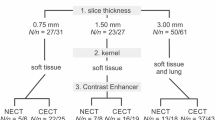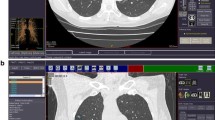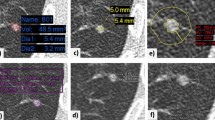Abstract
The purpose of this study was to evaluate the performance of a computer-assisted diagnostic (CAD) tool using various reconstruction slice thicknesses (RST). Image data of 20 patients undergoing multislice CT for pulmonary metastasis were reconstructed at 4.0, 2.0 and 0.75 mm RST and assessed by two blinded radiologists (R1 and R2) and CAD. Data were compared against an independent reference standard. Nodule subgroups (diameter >10, 4–10, <4 mm) were assessed separately. Statistical methods were the ROC analysis and Mann-Whitney U test. CAD was outperformed by readers at 4.0 mm (Az = 0.18, 0.62 and 0.69 for CAD, R1 and R2, respectively; P<0.05), comparable at 2.0 mm (Az = 0.57, 0.70 and 0.69 for CAD, R1 and R2, respectively), and superior using 0.75 mm RST (Az = 0.80, 0.70 and 0.70 and sensitivity = 0.74, 0.53 and 0.53 for CAD, R1 and R2, respectively; P<0.05). Reader performances were significantly enhanced by CAD (Az = 0.93 and 0.95 for R1 + CAD and R2 + CAD, respectively, P<0.05). The CAD advantage was best for nodules <10 mm (detection rates = 93.3, 89.9, 47.9 and 47.9% for R1 + CAD, R2 + CAD, R1 and R2, respectively). CAD using 0.75 mm RST outperformed radiologists in nodules below 10 mm in diameter and should be used to replace a second radiologist. CAD is not recommended for 4.0 mm RST.


Similar content being viewed by others
References
Ries L (1999) SEER Cancer statistics review, 1973–1996. National Cancer Institution, Bethesda
Henschke CI, McCauley DI, Yankelevitz DF, Naidich DP, McGuinness G, Miettinen OS, Libby D, Pasmantier M, Koizumi J, Altorki N, Smith JP (2001) Early lung cancer action project: a summary of the findings on baseline screening. Oncologist 6:147–152
Kaneko M, Eguchi K, Ohmatsu H, Kakinuma R, Naruke T, Suemasu K, Moriyama N (1996) Peripheral lung cancer: screening and detection with low-dose spiral-CT versus radiography. Radiology 201:798–802
Sone S, Li F, Yang ZG, Takashima S, Maruyama Y, Hasegawa M, Wang JC, Kawakami S, Honda T (2000) Characteristics of small lung cancers invisible on conventional chest radiography and detected by population based screening using spiral CT. Br J Radiol 73:137–145
Yankelevitz DF, Gupta R, Zhao B, Henschke CI (1999) Small pulmonary nodules: evaluation with repeat CT—preliminary experience. Radiology 212:561–566
Yankelevitz DF, Reeves AP, Kostis WJ, Zhao B, Henschke CI (2000) Small pulmonary nodules: volumetrically determined growth rates based on CT evaluation. Radiology 217:251–256
Ko JP, Betke M (2001) Chest CT: automated nodule detection and assessment of change over time—preliminary experience. Radiology 218:267–273
Zhao B, Gamsu G, Ginsber MS, Jiang L, Schwartz LH (2003) Automatic detection of small lung nodules on CT utilizing a local density maximum algorithm. J Appl Clin Med Phys 4:248–260
Naidich DP, Rusinek H, McGuinness G, Leitman B, McCauley DI, Henschke CI (1993) Variables affecting pulmonary nodule detection with computed tomography: evaluation with three-dimensional computer simulation. J Thorac Imaging 8:291–299
Henschke CI, Yankelevitz DF, Libby D, Kimmel M (2002) CT screening for lung cancer: the first 10 years. Cancer J 8:S47–S54
Swensen SJ, Jett JR, Sloan JA, Midthun DE, Hartman TE, Sykes AM, Aughenbaugh GL, Zink FE, Hillman SL, Noetzel GR, Marks RS, Clayton AC, Pairolero PC (2002) Screening for lung cancer with low-dose spiral computed tomography. Am J Respir Crit Care Med 165:508–513
Diederich S, Wormanns D, Semik M, Thomas M, Lenzen H, Roos N, Heindel W (2002) Screening for early lung cancer with low-dose spiral CT: prevalence in 817 asymptomatic smokers. Radiology 222:773–781
Swensen SJ, Jett JR, Hartman TE, Midthun DE, Sloan JA, Sykes AM, Aughenbaugh GL, Clemens MA (2003) Lung cancer screening with CT: Mayo Clinic experience. Radiology 226:756–761
Friese SA, Rieber A, Fleiter T, Brambs HJ, Claussen CD (1994) Pulmonary nodules in spiral volumetric and single slice computed tomography. Eur J Radiol 18:48–51
Fan L, Novak CL, Naidich DP, Wei G, Quian J, Ko JP (2002) Improving optimal radiologic interpretation of low-dose multi-slice lung CT studies using ICAD. Radiology 225:475 (RSNA abstract)
Press WH, Flamery BP, Teukolsky SA, Vetterling WTne (1992) Numerical recipes, the art of scientific computing. Cambridge University Press, Cambridge
Hanley JA, McNeil BJ (1982) The meaning and use of area under a receiver operating characteristic (ROC) curve. Radiology 143:29–36
DeLong ER, DeLong DM, Clarke-Pearson DL (1988) Comparing the areas under two or more correlated receiver operating curves: a nonparametric approach. Biometrics 44:837–845
Markus H, Bland JM, Rose G, Sitzer M, Siebler M (1996) How good is intercenter agreement in the identification of embolic signals in carotid artery disease? Stroke 27:1249–1252
Fiebich M, Wietholt C, Renger BC, Armato S III, Hoffmann K, Wormanns D, Diederich S (1999) Automatic detection of pulmonary nodules in low-dose screening thoracic CT examinations. Proc SPIE 3661:1434–1439
van Ginneken B, ter Haar Romeny BM, Viergever MA (2001) Computer-aided diagnosis in chest radiography: a survey. IEEE Trans Med Imaging 20:1228–1241
Masutani Y, Macmahon H, Doi K (2002) Computerized detection of pulmonary embolism in spiral CT angiography based on volumetric image analysis. IEEE Trans Med Imaging 21:1517–1523
Uppaluri R, Hoffman EA, Sonka M, Hunninghake GW, McLennan G (1999) Interstitial lung disease: a quantitative study using the adaptive multiple feature method. Am J Respir Crit Care Med 159:519–525
Wormanns D, Kohl G, Klotz E, Marheine A, Beyer F, Heindel W, Diederich S (2004) Volumetric measurements of pulmonary nodules at multi-row detector CT: in vivo reproducibility. Eur Radiol 14:86–92
Giger ML, Bae KT, MacMahon H (1994) Computerized detection of pulmonary nodules in computed tomography images. Invest Radiol 29:459–465
Armato SG III, Giger ML, MacMahon H (2001) Automated detection of lung nodules in CT scans: preliminary results. Med Phys 28:1552–1561
Fan L, Novak CL, Qian J, Kohl G, Naidich DP (2001) Automatic detection of lung nodules from multi-slice low-dose CT images. Proc SPIE 4322:1828–1835
Satoh H, Ukai Y, Niki N, Eguchi K, Mori K, Ohmatsu H, Kakinuma R, Kaneko M, Moriyama N (1999) Computer aided diagnosis system for lung cancer based on retrospective helical CT images. Proc SPIE 3661:1324–1335
Okumura T, Miwa T, Kako J, Yamamoto S, Matsumoto M, Tateno Y, Linuma T, Matsumoto T (1998) Image processing for computer-aided diagnosis of lung cancer screening system by CT (LSCT). Proc SPIE 3338:1314–1322
Lee Y, Hara T, Fujita H, Itoh S, Ishigaki T (2001) Automated detection of pulmonary nodules in helical CT images based on an improved template-matching technique. IEEE Trans Med Imaging 20:595–604
Lou S, Chang C, Lin K, Chen T (1999) Object-based deformation technique for 3-D CT lung nodule detection. Proc SPIE 3661:1544–1552
Brown MS, McNitt-Gray MF, Goldin JG, Suh RD, Sayre JW, Aberle DR (2001) Patient-specific models for lung nodule detection and surveillance in CT images. IEEE Trans Med Imaging 20:1242–1250
Taguchi H, Kawata Y, Niki N, Satoh H, Ohmatsu H, Kakinuma R, Eguchi K, Kaneko M, Moriyama N (1999) Lung cancer detection based on helical CT images using curved surface morphology analysis. Proc SPIE 3661:1307–1314
Wormanns D, Fiebich M, Saidi M, Diederich S, Heindel W (2002) Automatic detection of pulmonary nodules at spiral CT: clinical application of a computer-aided diagnosis system. Eur Radiol 12:1052–1057
Croisille P, Souto M, Cova M, Wood S, Afework Y, Kuhlman J, Zerhouni E (1995) Pulmonary nodules: improved detection with vascular segmentation and extraction with spiral CT. Radiology 197:397–401
Armato SG III, Giger ML, Moran CJ, Blackburn JT, Doi K, MacMahon H (1999) Computerized detection of pulmonary nodules on CT scans. Radiographics 19:1303–1311
Armato SG III, Li F, Giger ML, MacMahon H, Sone S, Doi K (2002) Lung cancer: performance of automated lung nodule detection applied to cancers missed in a CT screening program. Radiology 225:685–692
Rubin G, Naidich D, Sherbondy A, Lyo J, Napel S (2003) Inadequacy of lung nodule reference standard based upon standard methods of expert consensus review using cine-paging of transverse thin-section MDCT lung scans. Radiology 229:441–442 (RSNA abstract)
Marten K, Seyfarth T, Auer F, Wiener E, Grillhösl A, Obenauer S, Rummeny EJ, Engelke C (2004) Computer-assisted detection of pulmonary nodules: performance evaluation of an expert knowledge-based detection system in consensus reading with experienced and inexperienced chest radiologists. Eur Radiol 14:1930–1938
Herzog P, Seyfarth T, Shen H, Schoenberg S, Reiser M (2003) Performance of a computer-aided diagnosis tool for the detection of pulmonary nodules at multidetector-row CT data. Radiology 229:292 (RSNA abstract)
Miller D, Burns R, Schneider A, O’Shaughnessy K, Wood S, Castellino R (2003) A multi-reader, multi-case ROC study demonstrating improved performance detecting lung nodules using computer-aided detection (CAD) in multi-slice CT (MSCT) of the chest. Radiology 229:291–292 (RSNA abstract)
Acknowledgments
We thank Professor Charles E. Metz from the University of Chicago, USA and Professor John Martin Bland from the University of York, UK for invaluable advice on the statistical analysis.
Author information
Authors and Affiliations
Corresponding author
Rights and permissions
About this article
Cite this article
Marten, K., Grillhösl, A., Seyfarth, T. et al. Computer-assisted detection of pulmonary nodules: evaluation of diagnostic performance using an expert knowledge-based detection system with variable reconstruction slice thickness settings. Eur Radiol 15, 203–212 (2005). https://doi.org/10.1007/s00330-004-2544-5
Received:
Revised:
Accepted:
Published:
Issue Date:
DOI: https://doi.org/10.1007/s00330-004-2544-5




